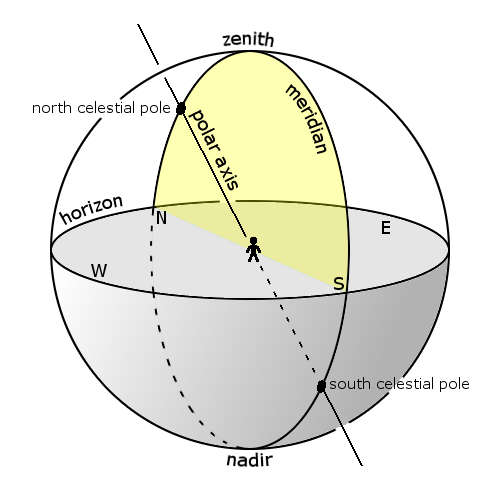Glossary M
Meridian. This is the great circle that passes through the celestial poles, and the observer's zenith and nadir. It crosses both the celestial equator and the observer's horizon at a right angle, and also marks the north and south points on the horizon. The part of the meridian above the horizon is the upper meridian, the part below is the lower meridian. At a given moment a celestial object will transit (cross) the upper meridian as the Earth rotates. When this occurs the object reaches its highest point in the sky (upper culmination). By definition the Sun transits the lower meridian at midnight and the upper meridian at midday, but this usually does not occur at precisely 00:00 and 12:00 UTC owing the equation of time, a seasonal anomaly in the its motion.
Metonic Cycle. A period of 19 years or 235 lunar months after which the same phase of the Moon occurs on the same day of the year. Meton of Athens (fl. 432 BCE), probably in the 430s BCE discovered the cycle in ancient Greece, but in fact it was well known to the Mesopotamians prior to that and possibly the Chinese. Indeed, it is quite possible that Meton derived his scheme from the Bablyonian one but there is no direct proof of that.
In modern terms, using the Tropical Year of 365.242188 days, the Metonic Cycle of 235 lunations, which is 6939.688415 (= 29.530589 × 235) days, is equivalent to 19.000238 (= 6939.688415 / 365.242188) Tropical Years, which is 2 hours, 4 minutes too long. Doing the same calculation with Julian years (365.25 days) reveals a deficit of 1 hour, 29 minutes.
Meton himself used 6940 days for 19 years, equivalent to 365 + 1/4 + 1/76 days, which gives a mean year length 365.263158 days (which exceeds the tropical year by 30 minutes), and matched this to 125 'full' months of 30 days each and 110 'hollow' months of 29 days each, using the usual Greek system. It seems he attempted to get this adopted by the Athenian authorities but was apparently rebuffed since there is no evidence for a regulated intercalation scheme in classical Athens. However, the Metonic Cycle does turn up in the Antikythera Mechanism and was probably widely used in Hellenistic and Roman times. The calculations were improved about a century later with the advent of the Kallippic Cycle.
Minute.
Moon. [Greek σελήνη] The Earth's only natural satellite has been a source of fascination, light and timekeeping for humans since prehistoric times. All ancient societies attributed divine characteristics to it as they did to other celestial objects, but the Greeks were amongst the first to speculate what it might actually be. In Homer, the Moon is always the celestial object, never a divine personification as it is in Hesiod's Theogony.
In the early C6th BCE, Anaximander implied by virtue of his strange wheels of fire concept that the Moon possesses its own light as did Anaximenes a little later. The idea that the Moon shone by reflected light appears first towards the middle of the C5th BCE in the philosophers Anaxagoras (Hippolytos Refutation of All Heresies 1.8.3–10; DK59A42) and Empedokles (Pseudo-Plutarch Miscellany 1.8.10; DK 31A30).
Moon Illusion. The optical illusion whereby the Moon (and also the Sun) appears to be bigger when it is near the horizon. The angular size of the Moon does not change when it is low in the sky and the ffect is not due to any atmospheric effect. Rather, it is a psychological phenomenon caused by the proximity of familiar objects on the horizon which, in a kind of repoussoir effect, cause the observer to judge that the Moon is further away (and hence larger) than it is when high in the sky.
In reality, the illusion is that the Moon appears smaller when high up because there is nothing to compare it with in the immediate field of vision. The phenomenon was first explained by Kleomedes and attributed to Posidonios.
Subscribe to:
Comments (Atom)
